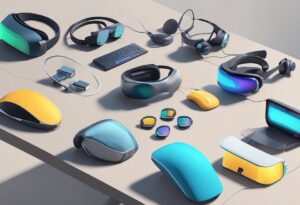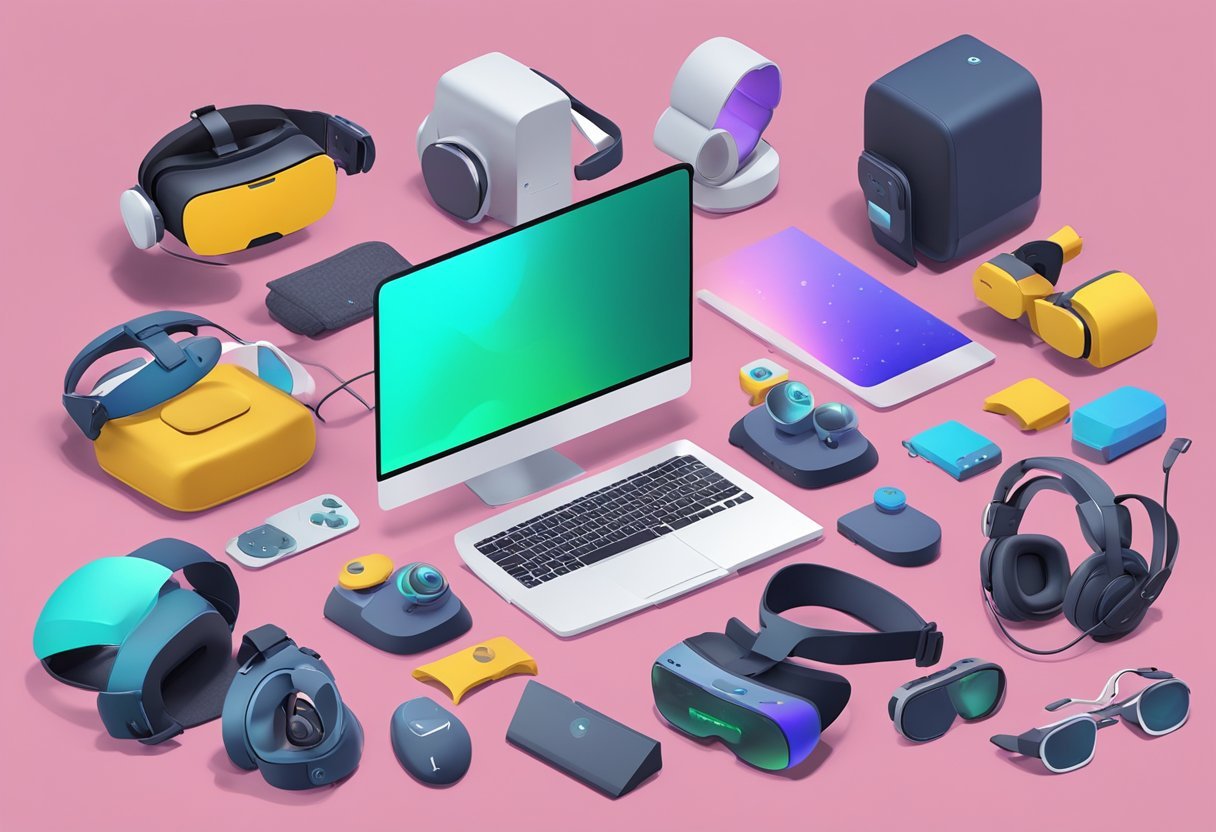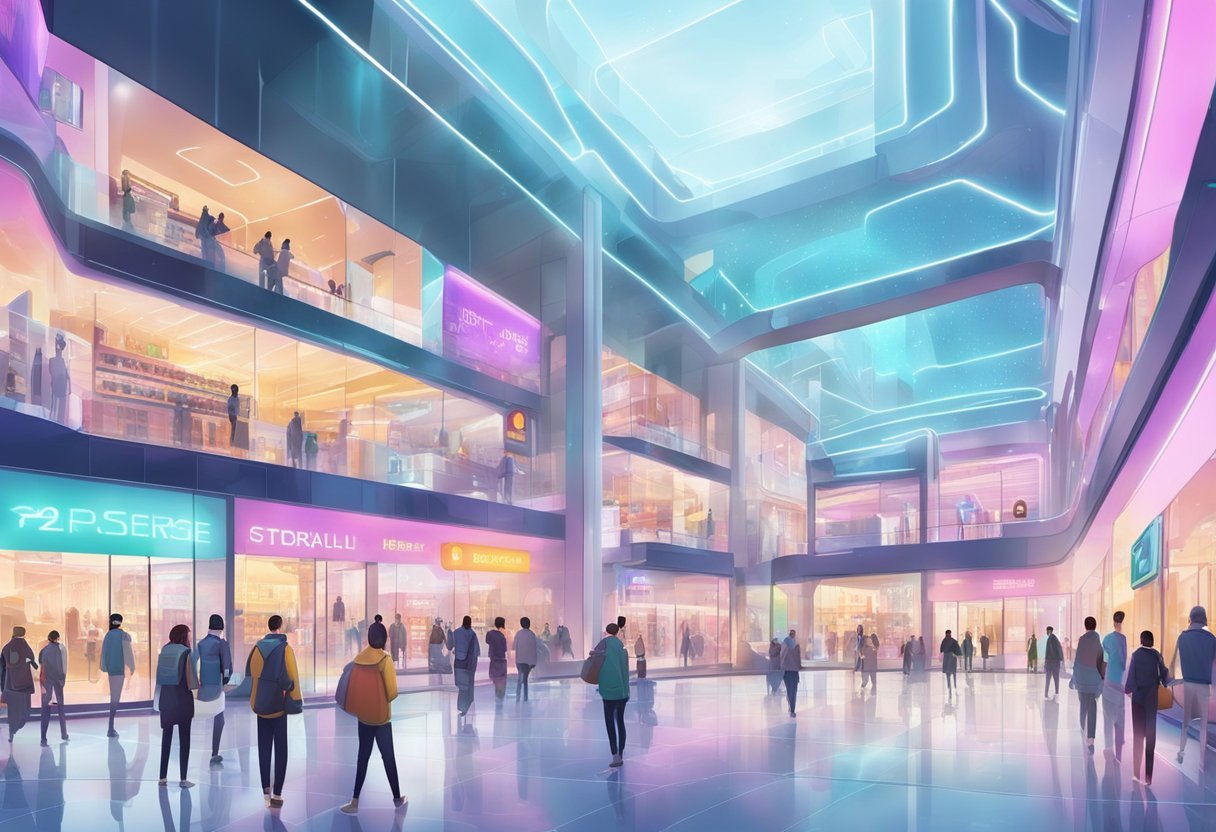The metaverse is a term used to describe a virtual world that is created by the convergence of physical and digital spaces. It is an immersive environment where users can interact with each other and with digital objects in real-time. The concept of the metaverse has been around for decades, but recent advancements in technology have made it more feasible than ever before. However, to fully realize the potential of the metaverse, hardware needs to keep up with the demands of this new world.
Virtual reality (VR) and augmented reality (AR) are two of the most promising technologies for creating a metaverse. VR allows users to fully immerse themselves in a digital environment, while AR overlays digital information onto the real world.
Both technologies require specialized hardware to work properly, such as headsets, controllers, and sensors. These devices need to be comfortable, intuitive, and responsive to provide a seamless experience, which is crucial for the success of the metaverse.
The development of metaverse hardware is a complex process that involves many different technologies and disciplines.
From semiconductors and cloud computing to security and privacy, every aspect of hardware needs to be carefully considered to ensure that the metaverse is accessible, safe, and enjoyable for everyone. As the metaverse continues to evolve, hardware will play a critical role in shaping its future.
Evolution of Metaverse Hardware
From Virtual Reality to Metaverse
Metaverse hardware has come a long way since the inception of virtual reality. Initially, VR headsets were heavy, expensive, and required powerful computers to run. However, with advancements in technology, VR headsets have become more compact, lighter, and affordable. The Oculus Quest 2, for instance, is a self-contained VR headset that does not require a PC or console to run.
As the metaverse continues to evolve, hardware manufacturers are shifting their focus from VR to AR glasses. AR glasses are more versatile than VR headsets as they allow users to interact with the real world while also overlaying digital content.
Google Glass was one of the first AR glasses to be released, but it failed to gain traction due to privacy concerns. However, companies like Apple and Facebook are now investing heavily in AR glasses, and it is expected that they will become the primary hardware for the metaverse in the future.
Key Tech Innovations
The development of the metaverse has been driven by several key tech innovations. One of the most significant innovations is the creation of the AR cloud. The AR cloud is a digital replica of the real world that can be accessed by AR glasses. It allows users to interact with virtual objects in the real world and vice versa.
Another crucial innovation is the use of non-fungible tokens (NFTs). NFTs are unique digital assets that can be used to represent ownership of virtual objects in the metaverse. They have the potential to revolutionize the way people buy, sell, and trade virtual assets.
The development of AI and machine learning is also driving the evolution of metaverse hardware. AI algorithms are being used to create more realistic and immersive virtual environments, while machine learning is being used to improve the performance of AR glasses.
Core Technologies Behind Metaverse Hardware
Computing Platforms
Metaverse hardware requires robust computing platforms to operate optimally. These platforms are responsible for running the complex algorithms that power virtual environments and enable real-time interactions between users.
Advanced computing platforms such as Artificial Intelligence (AI) and Machine Learning (ML) play a crucial role in the development of metaverse hardware. They enable the creation of intelligent systems that can adapt to user behavior, preferences, and requirements.
Processing Power
The processing power of metaverse hardware is critical to its performance. The hardware requires powerful processors to handle the complex calculations that underpin virtual environments.
Graphics Processing Units (GPUs) are an essential component of metaverse hardware, providing the necessary processing power to render high-quality graphics and support real-time interactions. The latest hardware developments have seen the emergence of dedicated metaverse processors, which are designed specifically for virtual environments.
Display Technologies
Display technologies are an essential component of metaverse hardware, providing users with immersive, high-quality visuals. The latest display technologies, such as OLED and 4K resolution, offer high levels of brightness, contrast, and color accuracy, providing users with a realistic and engaging virtual experience.
Advancements in display technologies have led to the development of lightweight, portable devices that can be worn or carried, such as VR headsets and AR glasses.
Metaverse hardware requires powerful computing platforms, processing power, and display technologies to deliver immersive virtual experiences. The latest advancements in AI, processors, GPUs, and display technologies have enabled the development of more sophisticated and efficient metaverse hardware.
As the metaverse continues to evolve, it is likely that hardware manufacturers will continue to push the boundaries of what is possible, delivering even more advanced and innovative technology.
Top 10 Metaverse Hardware
The Metaverse is a virtual world that is becoming increasingly popular, and the hardware used to access it is just as important as the software. Here are the top 10 Metaverse hardware devices that are currently available:
- Oculus Quest 2
- Valve Index
- HTC Vive Series
- Microsoft HoloLens 2
- Sony PlayStation VR
- HP Reverb G2
- Pimax 8K X
- TESLASUIT
- Razer Hydra
- Magic Leap 1
Oculus Quest 2
The Oculus Quest 2 is a standalone VR headset that provides an immersive Metaverse experience. It has a high-resolution display, a powerful processor, and is relatively affordable compared to other VR headsets.
Valve Index
The Valve Index is a high-end VR headset that offers a superior Metaverse experience. It has a high refresh rate, a wide field of view, and precise tracking, making it ideal for gaming and other immersive experiences.
HTC Vive Series
The HTC Vive Series is a popular VR headset that offers a comfortable and immersive Metaverse experience. It has a high-resolution display, precise tracking, and is compatible with a wide range of VR games and applications.
Microsoft HoloLens 2
The Microsoft HoloLens 2 is an augmented reality headset that allows users to interact with the Metaverse in a unique way. It has a wide field of view, precise tracking, and is ideal for enterprise applications such as training and remote collaboration.
Sony PlayStation VR
The Sony PlayStation VR is a VR headset that is designed specifically for use with the PlayStation gaming console. It has a high-resolution display, precise tracking, and is compatible with a wide range of VR games.
HP Reverb G2
The HP Reverb G2 is a high-end VR headset that provides an immersive Metaverse experience. It has a high-resolution display, precise tracking, and is ideal for gaming and other immersive experiences.
Pimax 8K X
The Pimax 8K X is a high-end VR headset that offers a superior Metaverse experience. It has a high-resolution display, a wide field of view, and precise tracking, making it ideal for gaming and other immersive experiences.
TESLASUIT
The TESLASUIT is a full-body haptic suit that allows users to feel the Metaverse. It has sensors that provide haptic feedback, allowing users to feel the virtual world around them.
Razer Hydra
The Razer Hydra is a motion controller that allows users to interact with the Metaverse. It has precise tracking and is ideal for gaming and other immersive experiences.
Magic Leap 1
The Magic Leap 1 is an augmented reality headset that allows users to interact with the Metaverse in a unique way. It has a wide field of view, precise tracking, and is ideal for enterprise applications such as training and remote collaboration.
The Metaverse is an exciting new world that is accessible through a variety of hardware devices. Whether you prefer VR headsets, motion controllers, or haptic suits, there is a Metaverse hardware device that is right for you.

Leading Companies and Products
Tech Giants’ Contributions
Several tech giants have made significant contributions to the development of metaverse hardware. Facebook’s Oculus Quest 2, for example, is a popular VR headset that can be used to access various metaverse platforms.
Apple has also been rumored to be working on its own AR/VR headset, which could potentially have metaverse capabilities. Google has invested in Reality Labs, which is working on AR/VR technologies that could be used in the metaverse. Microsoft has also been exploring the metaverse, with its Mesh platform aiming to create a shared virtual space.
Emerging Start-ups
In addition to tech giants, there are also several emerging start-ups that are working on metaverse hardware. Meta is one of the most well-known, having recently rebranded from Facebook to focus on the metaverse. The company is reportedly working on a pair of AR glasses that could be used to access the metaverse.
North is another start-up that is working on AR glasses, with a focus on creating a stylish and comfortable design. Venture capitalists are also investing in metaverse start-ups, such as SuperWorld, which is creating a virtual world that can be accessed through AR and VR devices.
User Experience and Interaction
Virtual and Augmented Realities
User experience (UX) is a crucial aspect of the metaverse, and it is essential to create an immersive and seamless virtual environment. The metaverse offers a unique opportunity to create a fully interactive and immersive experience for users.
Virtual and augmented realities are the primary ways users interact with the metaverse. VR headsets, AR glasses, and other hardware devices provide users with a sense of presence in the digital world.
To improve the user experience, hardware like servers and networking hardware must function seamlessly. The real-time communication capability in the virtual environment will be improved with the maturity of technologies such as 5G communication, cloud computing, and semiconductors.
The artistic design of user interaction experience for mobile should be considered to ensure that users can access the metaverse from any device.
Avatars and Digital Worlds
Avatars are digital representations of users in the metaverse. They allow users to interact with the digital world and other users. The design of avatars and digital worlds is essential to create an immersive and engaging experience for users. The hardware limitations can make designing user experiences for the metaverse challenging. From clunky headsets to other hardware carriers, the user experience can be negatively impacted.
Horizon worlds and Second Life are examples of digital worlds that have been successful in creating an immersive experience for their users.
The design of these worlds is crucial to the user experience. The user interface must be intuitive and easy to use, and the graphics must be high-quality to create a sense of immersion.
The user experience and interaction are crucial aspects of the metaverse. Creating an immersive and seamless virtual environment requires the use of advanced hardware like servers, networking hardware, and semiconductors. The design of avatars and digital worlds must be intuitive and engaging to create a sense of immersion for users.
Market Trends and Consumer Adoption
Pricing and Value Proposition
The adoption of metaverse hardware is expected to increase in the coming years as more consumers seek to explore the immersive virtual world. The price of metaverse hardware has become more affordable, making it accessible to a wider range of consumers.
The value proposition of metaverse hardware lies in its ability to provide a unique and immersive experience that cannot be replicated by traditional gaming or social platforms.
Smartphones and mobile devices are also playing a significant role in the adoption of metaverse hardware. The increasing power of mobile devices has made it possible to run metaverse applications on smartphones and tablets, which is expected to drive adoption further.
Adoption Barriers and Drivers
The adoption of metaverse hardware is not without its challenges. One of the main barriers to adoption is the complexity of the technology. Consumers may be hesitant to invest in hardware that requires a high level of technical expertise to operate.
However, the growing popularity of social platforms and online gaming has created a receptive audience for metaverse technology. Consumers are increasingly looking for new and engaging experiences, and metaverse hardware provides a unique opportunity to explore these experiences.
The market trends suggest that metaverse hardware is poised for growth in the coming years. The increasing affordability and accessibility of the technology, along with the growing demand for immersive experiences, are expected to drive adoption and expand the market.

Frequently Asked Questions
What are the essential components required to access the Metaverse?
To access the Metaverse, users require a computer or VR headset with a high-speed internet connection. The computer should have a powerful graphics card and processor to handle the complex graphics and interactions in the Metaverse. A webcam, microphone, and speakers are necessary for voice and video communication.
Which VR headsets are most compatible with the Metaverse?
Currently, the most compatible VR headsets with the Metaverse are Oculus Quest 2, HTC Vive, and Valve Index. These headsets have high-quality displays, sensors, and controllers that offer a seamless and immersive experience.
How do processing power requirements vary for different Metaverse experiences?
The processing power requirements vary depending on the complexity of the Metaverse experience. For instance, the graphics, physics, and interactions in a game-like Metaverse experience require more processing power than a simple virtual meeting.
Therefore, users should ensure that their computer or VR headset meets the recommended specifications for each Metaverse experience.
What peripherals enhance the immersive experience in the Metaverse?
Peripherals such as haptic feedback gloves, motion tracking suits, and omnidirectional treadmills enhance the immersive experience in the Metaverse. These peripherals offer realistic feedback and sensations that make the user feel like they are in the virtual world. However, they are not necessary for accessing the Metaverse.
Are there any specific brands leading in Metaverse-compatible hardware?
Currently, Oculus, HTC, and Valve are leading in Metaverse-compatible hardware due to their high-quality VR headsets and accessories. However, other brands such as Sony, Samsung, and Microsoft are also developing Metaverse-compatible hardware.
How might future technology advancements impact Metaverse hardware?
Future technology advancements such as 5G networks, artificial intelligence, and augmented reality could enhance the Metaverse experience.
For instance, users could access the Metaverse on their smartphones or use augmented reality glasses to overlay virtual objects onto the real world. Advancements in hardware such as more powerful processors and lighter VR headsets could make the Metaverse more accessible and immersive.




